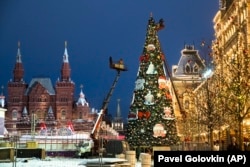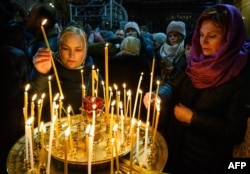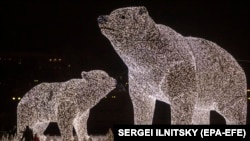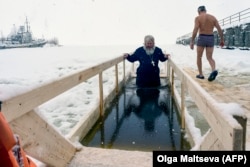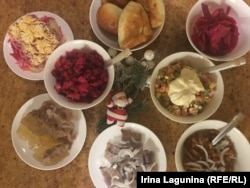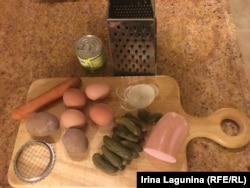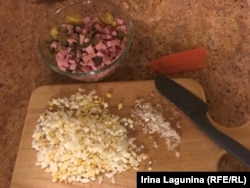As part of an occasional series on how the end-of-year holidays are celebrated in our broadcast region, we talked to Irina Lagunina from RFE/RL’s Russian Service about seasonal traditions in her country.
Western visitors to Russia at this time of year may be surprised to discover that the locals usually refer to the seasonally decorated conifers you see everywhere as “New Year firs” or “New Year spruces.”
So why would they call them this when they’re commonly known as Christmas trees in many other places?
According to Irina Lagunina from RFE/RL’s Russian Service, it’s largely a quirky legacy of the country’s Soviet past.
“It was really weird because, after the socialist revolution, the Bolsheviks actually banned not just the festivities of the Christmas season — this wonderful season of the year — but also the Christmas tree, which was considered to be a religious symbol,” she says.
“They decided that, since the main ideology is atheism, the Christmas tree should be banned. And that remained up until the mid-1930s when the New Year and the Christmas tree were kind of rehabilitated.”
When the Christmas tree was “rehabilitated” amid much fanfare in 1935, the official atheist ethos of the time ensured that it would primarily be associated with New Year celebrations and its Christian connotations were jettisoned.
It’s something that has endured to this day and the unveiling of the “New Year spruce” at the Kremlin every year is still a big event for thousands of children, although it is no longer decorated with a big Soviet star.
In a way, it’s perhaps fitting that the tree is still firmly associated with New Year’s rather than Christmas, as “Novy God” (New Year) has long been the focal point of the festive season in Russia.
Like many other Orthodox believers, most Russians typically celebrate Christmas Day on January 7. But for many, the day itself is quite low-key compared to other festivities that are observed in the country at this time of year.
“For those who celebrate it in Russia right now, Christmas is a purely religious event,” says Lagunina. “Believers go to the churches — the churches are actually full these days — but there is still no kind of notion and tradition of family gathering on this day or having something special.”
According to Lagunina, the main day of celebration “is actually not Christmas, but New Year.”
“It’s all about New Year,” she says. “This comes first in the Orthodox calendar, so Christmas is basically the next seven days, [but] the main festivity is New Year’s night, and that’s when Russians prepare the dinner of the year, the main celebration for family, unity, and so forth.”
Although Lagunina says New Year in Russia is “like everywhere else in the world, with a lot of champagne and a lot of fireworks,” it is also the centerpiece of a wider tapestry of formal and informal celebrations that are observed at this time of year.
“Well, in Russia right now, of course, there is a reason to celebrate everything,” she says. “Russians start to celebrate with the Western Christmas, then New Year, Orthodox Christmas…. Basically, it’s three weeks of festivities. You cannot get sober during this time!”
One of the most famous traditions observed during this period is not for the fainthearted.
“Ice swimming is a big deal in Russia,” says Lagunina, referring to the many hardy souls who brave the freezing waters of their local lakes and rivers for a bracing dip on January 19 to celebrate the Epiphany.
Amid all the festivities, however, New Year is always seen as the big event when people get together with close friends and relatives.
Gifts are exchanged and copious amounts of food and drink are often consumed.
Many families also take the time to watch The Irony Of Fate, a Trading Places kind of musical comedy that has been broadcast on state TV every New Year’s Day since 1976 and is now a firmly established tradition.
But it is frequently the food that is at the heart of New Year proceedings.
Lagunina says her seasonal table usually includes typical Russian fare, such as “pirozhki” pastries with various fillings and “kholodets” — cold stewed meat in aspic. Stuffed duck is also a very common dish on this day and “a regular middle-class family” might even have “a little bit of red caviar, sometimes salted salmon,” the main idea being that the choice of food on offer is “the best of what you can imagine.”
No New Year’s feast is complete, however, without a typical Russian salad or “Salad Olivier,” which according to legend was first invented by a French chef of that name while he was working in tsarist Russia.
Lagunina says a Salad Olivier is one of the “absolute must-have dishes on the table” at New Year. She puts the dish’s popularity down to its versatility, which allows it to be easily adapted for anyone observing a strict pre-Christmas fast.
“Olivier is made of peas, potatoes, carrots, pickles, ham, and mayonnaise, but the ham can be replaced,” she says. “Depending on how strong a believer you are, it can be replaced with chicken, crabmeat, fish, practically everything…. So it’s this kind of multicultural, multireligious, suitable-for-everybody dish, and you can even make it for vegetarians without any meat or chicken.”
How To Make Salad Olivier
Ingredients
1 small can of peas (100 grams)
1 large or two small potatoes, peeled and boiled
1 large boiled carrot
4 hard-boiled eggs
10 salted pickles (Irina makes these herself at home, but they can be shop-bought)
2 slices of sweet onion, finely chopped
200 grams (about 1/2 pound) of ham (common alternatives include a Mortadella type of sausage, crabmeat, boiled beef tongue, or fish. Irina has chosen “Doktorskaya kolbasa or “Doctor’s sausage,” a lunch meat that has been popular in Russia since Soviet times.)
Method
“Like all Russian salads, all the items should be the size of the smallest ingredient that cannot be divided,” says Lagunina. “The peas are the smallest undividable element, so everything you cut should be the size of a pea [at most]. That’s the basis of all Russian salads.”
As everything should be cut into pea-sized cubes, Lagunina uses a potato slicer for this purpose.
“This tool is very popular not only in Russia but also in the Czech Republic, Austria, and all other places where they make potato salad,” she says.
Lagunina is in favor of breaking with tradition and grating the carrots even smaller, however, as cutting them into cubes gives the salad “an overwhelming taste.”
Like the carrots, Lagunina also prefers to cut the eggs smaller than the peas, as they help “cement the salad.”
Once all the ingredients have been tossed in a bowl, mix in some mayonnaise (according to taste) and sprinkle with black pepper as the “final touch.”
Lagunina stresses that the mayonnaise should be added “only before you serve the salad on the table,” as it will ensure a “fresher” flavor.
Written by Coilin O’Connor based on an interview with Irina Lagunina from RFE/RL’s Russian Service
This post was originally published on Radio Free.


